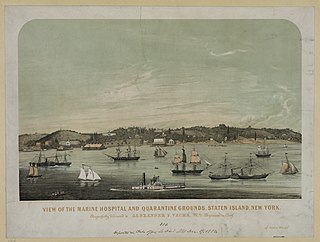Related Research Articles

The Centers for Disease Control and Prevention (CDC) is the national public health agency of the United States. It is a United States federal agency under the Department of Health and Human Services, and is headquartered in Atlanta, Georgia.

A quarantine is a restriction on the movement of people, animals and goods which is intended to prevent the spread of disease or pests. It is often used in connection to disease and illness, preventing the movement of those who may have been exposed to a communicable disease, yet do not have a confirmed medical diagnosis. It is distinct from medical isolation, in which those confirmed to be infected with a communicable disease are isolated from the healthy population. Quarantine considerations are often one aspect of border control.

The United States Public Health Service is a collection of agencies of the Department of Health and Human Services concerned with public health, containing nine out of the department's twelve operating divisions. The Assistant Secretary for Health oversees the PHS. The Public Health Service Commissioned Corps (PHSCC) is the federal uniformed service of the PHS, and is one of the eight uniformed services of the United States.

John Maynard Woodworth was an American physician and member of the Woodworth political family. He served as the first Supervising-Surgeon General under president Ulysses S. Grant, then changed to Surgeon General of the United States Marine Hospital Service from 1871 to 1879.

The Marine Hospital Service was an organization of Marine Hospitals dedicated to the care of ill and disabled seamen in the United States Merchant Marine, the U.S. Coast Guard and other federal beneficiaries. The Marine Hospital Service evolved into the U.S. Public Health Service.

John Brown Hamilton was an American physician and soldier. He was appointed the second Surgeon General of the United States from 1879 to 1891.

David Satcher, is an American physician, and public health administrator. He was a four-star admiral in the United States Public Health Service Commissioned Corps and served as the 10th Assistant Secretary for Health, and the 16th Surgeon General of the United States.

The Public Health Service Act is a United States federal law enacted in 1944. The full act is codified in Title 42 of the United States Code, Chapter 6A . This Act provided a legislative basis for the provision of public health services in the United States.

The National Centre for Infectious Diseases, previously known as the Communicable Disease Centre, is a national public health institute under the Ministry of Health of Singapore. Located next to Tan Tock Seng Hospital in Novena, all patients within the city-state who are affected with a highly contagious disease are also quarantined at the NCID and is used to control an outbreak of such diseases. The executive director of the hospital is Professor Yee-Sin Leo.

Joseph James Kinyoun was an American physician and the founder of the United States' Hygienic Laboratory, the predecessor of the National Institutes of Health.

Public Health Reports is a peer-reviewed public health journal established in 1878 and published by SAGE Publishing for the Association of Schools and Programs of Public Health and the United States Public Health Service. The title and publication frequency of the journal has varied over the years, but it is currently published bimonthly. The editor-in-chief is Hazel D. Dean. Articles are published under a delayed open access, where they become fully open access one year after publication. Some special articles are published as open access including regularly published commentaries by the US Surgeon General and other top United States Department of Health and Human Services officials.

Joseph Walter Mountin MD was an American physician and career United States Public Health Service (USPHS) officer who was the founder of the U.S. Centers for Disease Control and Prevention in Atlanta, Georgia. Mountin eventually became an assistant surgeon general. He was involved in many advancements in medical and sanitary science during his lifetime. He was an early advocate for a national health care system and wrote frequently on the need to provide broader health care coverage. He was considered influential in the development of public health improvements.
This is a timeline of the United States Public Health Service Commissioned Corps and its predecessor, the Marine Hospital Service.

The Staten Island Quarantine War was a series of attacks on the New York Marine Hospital in Staten Island—known as "the Quarantine" and at that time the largest quarantine facility in the United States—on September 1 and 2, 1858. The attacks, perpetrated mainly by residents of Staten Island, which had not yet joined New York City, were a result of longstanding local opposition to several quarantine facilities on the island's East Shore. During the attacks, arsonists set a large fire that completely destroyed the hospital compound. At trial, the leaders of the attack successfully argued that they had destroyed the Quarantine in self-defense. Though there were no deaths as a direct result of the attacks, the conflict serves as an important historical case study of the use of quarantines as a first response.

The Division of Global Migration Health (DGMH), formerly the Division of Global Migration and Quarantine is the part of the U.S. government responsible for U.S. Quarantine Stations and issuing quarantine orders. It is part of the National Center for Emerging and Zoonotic Infectious Diseases within the Centers for Disease Control and Prevention (CDC).

Robert J. Anderson was the chief of the Communicable Disease Center (CDC) of the United States Public Health Service, forerunner to the modern Centers for Disease Control and Prevention, from October 1, 1956, to June 30, 1960.

The Bureau of State Services (BSS) was one of three principal operating agencies of the United States Public Health Service (PHS) from 1943 until 1966. The bureau contained the PHS divisions that administered cooperative services to U.S. states through technical and financial assistance, and included significant programs in community health, environmental health, and workforce development.

The Bureau of Medical Services (BMS) was a unit of the United States Public Health Service (PHS) that existed in two incarnations. The first was one of three principal operating agencies of PHS from 1943 until 1966, while the second was a division of the PHS Health Services Administration from 1973 until 1982. Both incarnations of the bureau had the principal responsibility of operating the PHS hospital system that had been founded in 1789.

National Quarantine Act of 1878 established quarantine regulations for foreign nautical vessels pursuing entrance into United States maritime ports. The United States statute declared it to be an unlawful pursuit for international vessels departing harbors termed as infected maritime ports to enter United States seaports and territorial waters. The Act of Congress authorized the prevention of communicable and transmissible diseases from entering or being introduced by any vehicle beyond the borders of the United States.
References
- ↑ Smillie, W. G. (1943). "The National Board of Health 1879-1883". American Journal of Public Health and the Nation's Health. 33 (8): 925–930. doi:10.2105/AJPH.33.8.925. ISSN 0002-9572. PMC 1527526 . PMID 18015860.
- ↑ Folsom, Charles F. (1879-12-25). "The National Board of Health" (PDF). The Boston Medical and Surgical Journal. 101 (26): 927–928. doi:10.1056/NEJM187912251012610. ISSN 0096-6762.
- 1 2 "FORTY-FIFTH CONGRESS. SESS. III" (PDF). Library of Congress. Retrieved 2018-12-13.
- ↑ "A National Board of Health". Journal of the American Medical Association. III (25): 694–696. 1884-12-20. doi:10.1001/jama.1884.02390740022008. ISSN 0002-9955.
- ↑ "FORTY-FIFTH CONGRESS. SESS.II. IIC. 61,62,64,66" (PDF). Library of Congress. Retrieved 2018-12-13.
- 1 2 Gray, Thomas R.; Jenkins, Jeffery A. (2021). "Yellow Fever and Institutional Development: The Rise and Fall of the National Board of Health". Journal of Political Institutions and Political Economy. 2 (1): 143–167. doi:10.1561/113.00000033. ISSN 2689-4823.
- ↑ Allen, William (1900). "The Rise of the National Board of Health". The Rise of the National Board of Health. 15: 51–68. JSTOR 1009297.
- 1 2 Michael, Jerrold M (2011). "The National Board of Health: 1879–1883". Public Health Reports. 126 (1): 123–129. ISSN 0033-3549. PMC 3001811 . PMID 21337938.